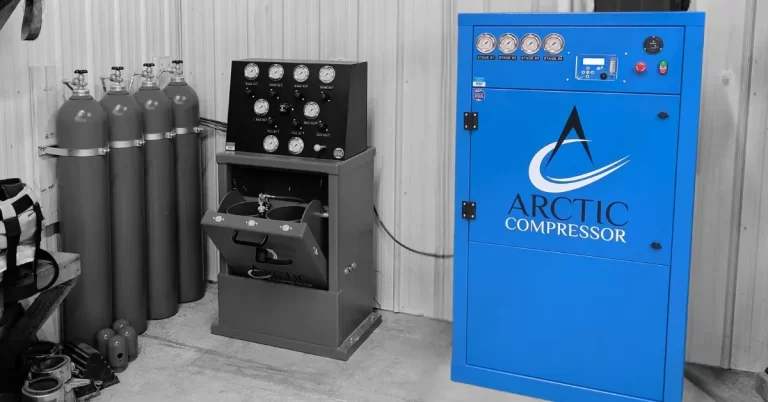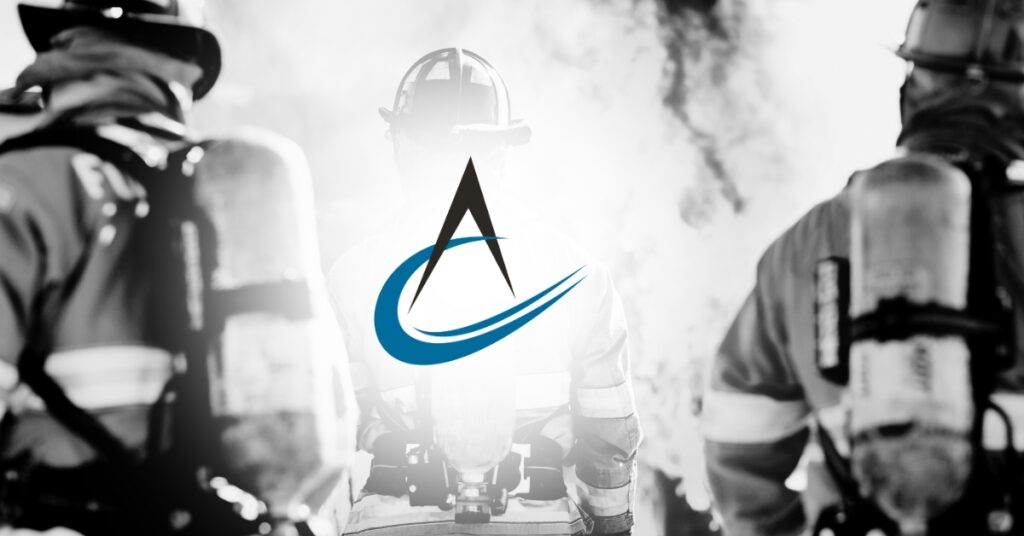
Breathing air compressors play a vital role for professionals who rely on Self Contained Breathing Apparatuses (SCBAs) to safely breathe in challenging or emergency environments. Whether in firefighting, scuba diving, or various industrial settings, these specialized compressors deliver the high-pressure, purified air essential for safety and performance.
In this guide, we will explore:
A breathing air compressor is a specialized high-pressure air compressor. These units compress ambient or atmospheric air to high pressures, often exceeding 6000 PSI. While compressing air, they also process it to be acceptable for breathing purposes, meeting or exceeding standards set by regulatory bodies like the Compressed Gas Association (CGA).
Unlike standard compressors, breathing air compressors incorporate advanced filtration systems that remove contaminants, moisture, and harmful gases to produce air that meets or exceeds CGA safety standards.
Breathing air compressors come in various configurations to meet different operational needs and environments, but all fall into two categories; portable and stationary.
Designed for mobility and flexibility in deployment, portable or mobile systems offer:
Mobile breathing air compressors are often used by:
Portable units are particularly valuable for situations where permanent installations aren’t possible or when a unit is meant to support the breathing air needs of multiple locations.
Stationary systems are designed for consistent, high-volume cylinder refilling in a frequently utilized space. They offer:
Stationary systems are often utilized by:
Stationary systems provide the backbone of breathing air infrastructure where regular, high-volume usage is expected.
Arctic Compressor offers both stationary and portable breathing air compressors.
When choosing an SCBA compressor, noise level is a key factor—especially in shared or sensitive environments. There are two main types of compressors: enclosed or open frame.
Enclosed SCBA compressors are designed with sound-dampening cabinets that reduce noise to as low as 83 dB at 1 meter while protecting internal components from dust, moisture, and debris. They’re ideal for fire stations or indoor installations where teams need to communicate easily.
Open-frame SCBA compressors, on the other hand, offer a more budget-friendly and accessible option for installations in dedicated rooms. While louder and more exposed to environmental elements, they feature a lower profile and cost, making them suitable for cost-sensitive applications. Choosing between enclosed and open frame models depends on your performance needs, space limitations, and environmental conditions.
The power source driving a breathing air compressor determines where and how it can be deployed, with significant implications for operational flexibility, maintenance requirements, and long-term costs. Three primary power options dominate the market: electric, gas, and diesel. However, the gold standard for indoor breathing air compressors is electric.
Electric-powered compressors represent the most common choice for permanent installations, offering clean and consistent operation. Compared to gas and diesel powered compressors, they offer:
Electric compressors are often utilized by teams who want reliable, consistent, quiet, and clean compressors in their area. They remain the gold standard for permanent installations.
All Arctic Compressors are electric and come in different configurations to accommodate the needs of organization or station.
The stages of air compression determine performance, efficiency, and air quality. Nearly all breathing air compressors come in multi-stage forms, but there are a few nuances to consider.
Multi-stage breathing air compressors typically come in two options: 3-stages or 4-stages.
3-stage compressors offer users:
However, a 4-stage compressor offers:
To further understand the differences between a 3-stage and 4-stage breathing air compressor, check out our article 3-Stage vs. 4-Stage Compressors Explained.
CGA has established stringent standards to ensure the health of compressed breathing air users. Understanding the difference between Grade D and Grade E breathing air quality informs what compressor is the right investment for your usage. Download our Breathing Air Quality Standards to see the difference.
All Arctic Compressors exceed CGA Grade E breathing air standards, bringing you the highest quality air.

When selecting a breathing air compressor, consider:
Assessing these needs for your department or organization can be a daunting task. Arctic Compressor experts are ready to help you determine the best solutions for your situation. Get in touch with us today.
There are several other components to consider in a breathing air system. Check out our experts tips > Breathing Air Systems: Your Complete Guide.
A breathing air compressor is a specialized high-pressure air compressor that compresses atmospheric air to fill SCBA cylinders. Breathing air must meet stringent quality standards and use advanced filtration to remove any contaminants in the compressed air.
The best breathing air compressor has three main components: advanced filtration, multiple stages, and air quality that meets or exceeds CGA Grade E breathing air standards.
Arctic Compressor offers the gold standard breathing air compressors in the market. Our compressors exceed CGA Grade E standards, are simple to use, and are renowned for their quiet operation.
At a minimum, a breathing air compressor must meet CGA Grade D breathing air standards. However, users should prioritize finding a breathing air compressor that meets or exceeds CGA Grade E breathing air standards.
Arctic Compressor prioritizes safety and exceptional breathing air. Our compressed air exceeds CGA Grade E standards.
Stationary breathing air compressors are often located in a mechanical room where they are away from contaminants and fumes that can contaminate the atmospheric air.
Compressed air and breathing air are similar in that the air is compressed. However, compressed air does not need to meet stringent breathing air standards or have specialized filtration and integrated monitoring systems. Breathing air is often compressed to much higher PSI levels than standard compressed air, often exceeding 6000 PSI.

Arctic Compressor LLC produces High-Pressure Air compressors and Containment Fill Stations for use in the fire safety, industrial, and recreational markets. We have been designing and building high-pressure compressors for more than 30 years.
Phone:
Copyright 2025 – Arctic Compressor “The simple Choice”. All rights Reserved